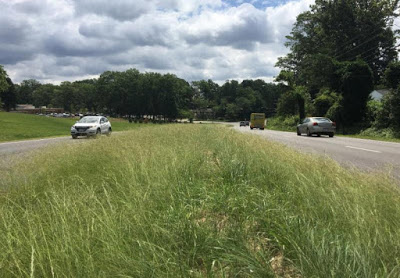Supervisors urge VDOT to step up grass mowing
 |
| An overgrown median strip. |
Supervisors Jeff McKay (Lee) and John Cook (Braddock) announced June 19 that they are sending a joint letter to Virginia Department of Transportation officials calling for improved grass maintenance in Fairfax County.
The supervisors urge Virginia Transportation Secretary Aubrey Layne to reinstitute the policy of six mowing cycles a year. They have received numerous complaints about overgrown grass in neighborhoods and along high-density roadways. The unkempt grass is not only an eyesore; it’s a safety hazard.
“Many residents in Lee District and across the county rely on well-maintained sidewalks to travel to bus stops, get around their neighborhoods, and visit local businesses,” McKay says. “Poorly maintained sidewalks and medians reduce driver visibility, discourage travel around neighborhoods, and make life difficult for children, senior citizens, and working families.”
“This is first and foremost a safety issue,” says Cook. “Our roads are heavily traveled and those making left turns or U-turns sometimes must put themselves and others at risk because tall grass blocks their view.”
In addition, tall grass encourages more ticks, which often carry Lyme Disease, and could have a negative impact on property values.
The mild winter and lack of need for continued snowplowing left unallocated funding in VDOT’s road maintenance budget, the supervisors point out, and those funds could be used for mowing.
VDOT used to mow six times a year. But that was cut to three during the recession, and the recession is now over, Cook says. “Furthermore, Fairfax residents are paying an extra penny on the sales tax to Richmond to fund transportation needs. If people in Fairfax are going to pay more, they have a right to see basic maintenance at least as good as pre-recession levels.”
VDOT mowing practices often directly conflict with localities’ expectations of homeowners, McKay adds. “It doesn’t make sense that residents are held to a higher standard of grass maintenance than the state government.”


Not only grass, but litter! It's time to stop spending so much money cutting down trees and more on litter pickup and anti-litter education in the schools.
Whomever they employ to mow does not do a good job. They leave strips of unmowed grass. Why don't they grow wildflowers instead of grass…prettier and less expensive than mowing!!!
"Studly": you may be glad to know that Belvedere Elementary on Columbia Pike has a strong, active environmental education program (for both students and teachers) that works year-round on teaching about the environment and protecting it through things like reduce-reuse-recycle. It goes way beyond that, though. One major transdisiplinary theme of the Primary Years Program (International Baccalaureate curriculum) in place for all students there focuses on the environment in many ways: how we use natural resources; how we impact plants, animals, and the environment–as well as the ways they impact us; and an appreciation of aesthetics, to name a few.
The school grounds are registered as a Backyard/Schoolyard Habitat with the National Wildlife Federation and include a multitude of planting beds (including a "decomposition garden") as well as a couple of outdoor classrooms. There’s a club of staff, students, and their families that takes nature hikes in the nearby areas once a month. We even have a group called Waste Watchers that tracks refuse, then comes up with ways to reduce that and reminds students and staff how to follow through. One result has included the elimination of Styrofoam lunch trays from the cafeteria.
Anyone who wants to set up a Backyard Habitat of their own can learn more on the National Wildlife Federation website.
Wildflowers are definitely better, but they can grow at least as tall as grass–around here, I love to see the chicory sprouting up and hate to see it cut down. Some other native flowers, like the striking star-shaped horse nettle, are also quite prickly. Not practical for public areas, I guess. It'd be a shame (and a mistake) for the county to spend money on non-native wildflower seeds.
Clover, on the other hand, could be a very practical mix-in because it's hardy, spreads well, and usually only grows 2-8 inches. It's only gotten a bad reputation since people started aspiring to the unrealistically uniform green carpet look–which is ironically quite bad for the environment and hard to achieve/maintain! Go natural, peeps.